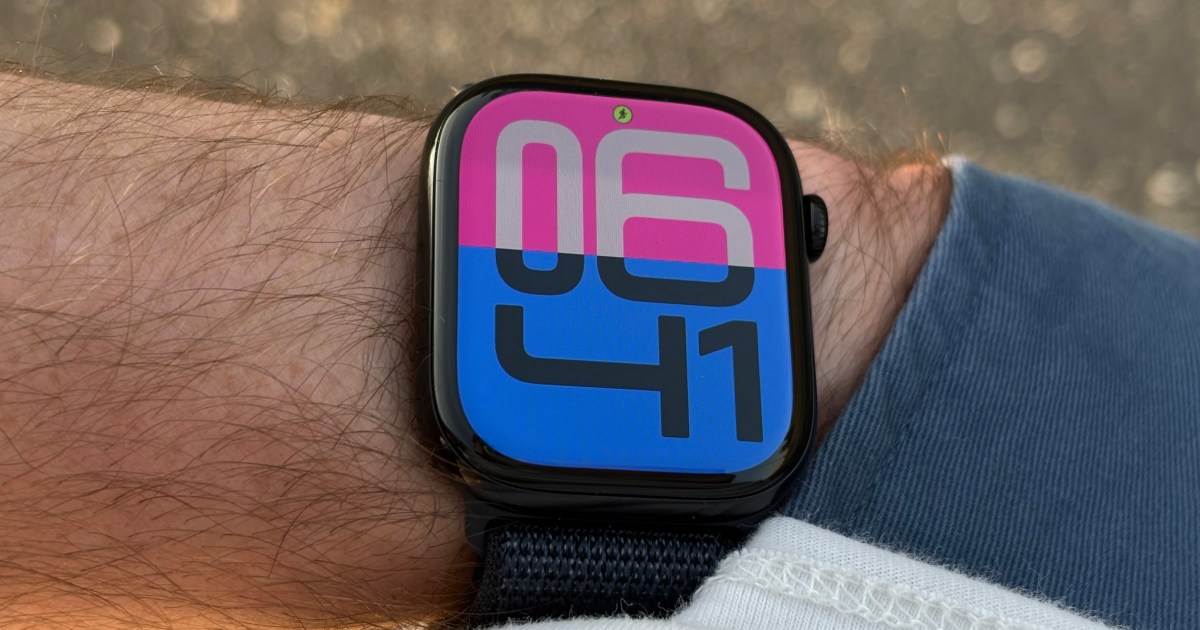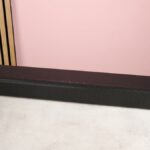When it comes to smartwatches, Apple is quite dominant in the market with the Apple Watch. In fact, it has just hit the 10-year mark with the Apple Watch Series 10, which is proving to be a big hit for many. With a slimmer design, larger display, new finishes, and a faster S10 chip, there’s definitely a lot to love here.
But what if you have an Apple Watch Series 8? Have things changed enough in two years to warrant an upgrade? Let’s find out.
Apple Watch Series 10 vs. Series 8: specs
| Apple Watch Series 10 | Apple Watch Series 8 | |
| Case size | 46mm: 46 x 39 x 9.7mm
42mm: 42 x 36 x 9.7 mm |
45mm: 45 x 38 x 10.7mm
41mm: 41mm x 35 x 10.7mm |
| Weight | 46mm:
36.4 grams (aluminum, GPS) 35.3 grams (aluminum, GPS + Cellular) 41.7 grams (titanium) 42mm: 30 grams (aluminum, GPS) 29.3 grams (aluminum, GPS + Cellular) 34.4 grams (titanium) |
45mm:
38.8 grams (aluminum, GPS) 39.1 grams (aluminum, GPS + Cellular) 51.5 grams (stainless steel) 41mm: 31.9 grams (aluminum, GPS) 32.2 grams (aluminum, GPS + Cellular) 42.3 grams (stainless steel) |
| Display | LTPO3 OLED Always-on Retina display
Wide-angle OLED Up to 2,000 nits brightness 1 nit minimum brightness 416 x 496 pixel resolution, 1220 sq mm display area (46mm) 374 x 446 pixel resolution, 989 sq mm display area (42mm) |
LTPO OLED Always-on Retina display
Up to 1,000 nits brightness 396 x 484 pixel resolution, 1143 sq mm display area (45mm) 352 x 430 pixel resolution, 904 sq mm display area |
| Software | watchOS 11 | watchOS 11 |
| Updates | At least five years
Released 2024 |
At least five years
Released 2022 |
| Processor | S10 SiP | S8 SiP |
| Storage | 64GB | 32GB |
| Health tracking | Electrical heart sensor (ECG)
Third-generation optical heart sensor Cycle Tracking with retrospective ovulation estimates Nightly wrist temperature tracking Sleep tracking Sleep apnea detection |
Electrical heart sensor (ECG)
Third-generation optical heart sensor Cycle Tracking with retrospective ovulation estimates Nightly wrist temperature tracking Sleep tracking Blood-oxygen monitoring |
| Battery life | Up to 18 hours | Up to 18 hours |
| Charging | 0-80% in 30 minutes | 0-80% in 45 minutes |
| Price | Starts at $399 | Available at select retailers |
| Review | Apple Watch Series 10 review | Apple Watch Series 8 review |
Apple Watch Series 10 vs. Series 8: design
Though the Apple Watch Series 10 did get a slight design change, it wasn’t a drastic redesign. So the overall appearance is very similar to the Series 8, but with some differences.
First, the Apple Watch Series 10 has two new sizes: 42mm and 46mm, while the Series 8 was 41mm or 45mm. The body of the Series 10 is also thinner and lighter than any Apple Watch before it, including the Series 8. When you look at it from the surface, it doesn’t look much different, but you can definitely feel it when you wear it.
The Apple Watch Series 8 also comes in aluminum and stainless steel finishes, with a ceramic and sapphire crystal backing. For the Apple Watch Series 10, it comes in aluminum and a new titanium finish, with a metal and sapphire crystal backing.

Color options for the Apple Watch Series 10 include rose gold and silver aluminum, jet black aluminum (polished finish), and slate, gold, and natural titanium options. For the Series 8, it originally came in silver, starlight, midnight, and PRODUCT(RED) color options for the aluminum, and graphite, gold, or silver stainless steel.
Again, the overall look of the Apple Watch Series 10 doesn’t appear drastically different than the Series 8. But the new finishes, slimmer design, and larger display make it a worthwhile upgrade.
Apple Watch Series 10 vs. Series 8: display

The differences in the displays is more apparent than the overall design between the Apple Watch Series 10 and its predecessors.
With the Apple Watch Series 10, Apple uses a new wide-angle OLED display that extends a bit farther down the sides of the body than previous models. This helps with the larger display size, especially on the 46mm version, and makes it easier to see the Apple Watch display from any position, as it’s 40% brighter when viewed at an angle.
The Apple Watch Series 10 also has an LTPO3 OLED always-on Retina display, which is also more power efficient than the older LTPO display with the Series 8. The Series 10 also can get double the brightness at 2,000 nits, and goes down to a minimum of 1 nit for dark environments.

For resolution, the Apple Watch Series 10 is 374 x 446 pixels with 989 sq mm display area for the 42mm, and 416 x 496 pixels with a 1220 sq mm display area on the 46mm. This is compared to the Series 8’s 352 x 430 and 904 (41mm) and 396 x 484 pixels with 1143 sq mm display area, respectively.
For reference, the Series 10 also beats out the display on the Apple Watch Ultra 2, as that one is 410 x 502 pixels with 1185 sq mm display area.
It’s quite clear — the Apple Watch Series 10 has one of the largest displays that Apple has put on a wearable.
Apple Watch Series 10 vs. Series 8: software and performance

Both the Apple Watch Series 10 and Series 8 can run watchOS 11. Apple typically supports its devices for at least five years, however. Since the Apple Watch Series 8 came out in 2022, it may only last for another three years at this point. But since the Apple Watch Series 10 just came out, it should last through 2029.
Since the Apple Watch Series 8 came out in 2022, it is using the older S8 SiP and has 32GB storage. Meanwhile, the Series 10 has the latest S10 SiP and 64GB storage. This allows for faster, on-device Siri with health data access, as well as the Double Tap gesture, both of which were introduced with the Series 9 and Apple Watch Ultra 2 because of the faster S9 SiP. These features are not available on the Series 8.

With watchOS 11, there are some nice quality of life improvements that Apple made. For one, it adds pause days for the Activity rings, allowing you to take a break when you’re not feeling the best, without breaking your award streak. There’s also customizable Activity ring goals for each day of the week as you see fit.
The Vitals app in watchOS 11 is also great if you tend to wear your Apple Watch to sleep. It will show you any outliers that you should pay attention to. Since the Apple Watch Series 10 feels much lighter than its predecessors, the Vitals app really makes sense with the newest smartwatch.
There are a lot of other nifty features in watchOS 11, like Training Load for runners, improved Smart Stacks, check-in with loved ones when you reach a destination, and more. Both the Series 10 and Series 8 can get watchOS 11, but the Series 10 has more life left in it at this point.
Apple Watch Series 10 vs. Series 8: health tracking and sensors

For the most part, the Apple Watch Series 10 and Series 8 have the same health and fitness tracking features. This includes the third-generation optical heart rate sensor, electrical heart sensor (ECG), nightly wrist temperature tracking, cycle tracking with retrospective ovulation estimates, and sleep tracking.
But there are some minor differences. For one, the Series 8 still has blood-oxygen monitoring, which is not currently present in the Series 10 in the U.S. This is because of the ongoing legal issues between Apple and Masimo, with the latter claiming that Apple has infringed on its patented wearable technology. Apple removed the blood-oxygen feature from Apple Watches sold since January 18, 2024. Until the legal issues are settled, any new Apple Watch, including the Series 10, will not have the blood-oxygen feature in the U.S. Since most Apple Watch Series 8 watches were sold before all of this, it still has that feature — as long as you’re not buying it new, of course.

The Apple Watch Series 10 does have a new health tracking feature that isn’t coming to the Series 8, however. Apple has added sleep apnea detection with the Series 10, and it’s also coming to the Series 9 and Ultra 2 as well. The sleep apnea detection works by utilizing the new Breathing Disturbances metric, which uses the accelerometer in the Apple Watch to keep track of how often you are moving around at night. Such movements can be an interruption in sleep, and this is analyzed every 30 days. When there are consistent signs of moderate to severe sleep apnea, the Apple Watch Series 10 will notify you.
There are advantages to both the Series 8 and Series 10 right now. If you’re in the U.S. and still want to have blood-oxygen monitoring, you might want to stick with the Apple Watch Series 8 until those legal issues are resolved. But if you don’t need to be constantly checking your blood-oxygen levels, and are more interested in sleep apnea detection, then the Series 10 is the way to go.
Apple Watch Series 10 vs. Series 8: battery life and charging

As far as battery life goes, there isn’t too much difference between the new Apple Watch Series 10 and Series 8. Apple claims around 18 hours of battery life for both — the battery life for the main Apple Watch has been a constant throughout the years. Only the Apple Watch Ultra models have double battery life at around 36 hours.
Where the Series 10 and Series 8 differ, though, is with the charging speed. While the Series 8 can get a 0 to 80% charge in 45 minutes, the Series 10 can get that same charge in just 30 minutes. Though it’s not quite the same as the 36 hours of normal battery life of the Apple Watch Ultra, the very fast charging speed for the Series 10 kind of makes up for it.
Apple Watch Series 10 vs. Series 8: price and availability

As of right now, you can’t purchase the Apple Watch Series 8 anymore, at least directly from Apple. However, it does appear that some refurbished Series 8 models are available on select retailers like Amazon for around $250.
Since the Apple Watch Series 10 is new, you can find it at pretty much all the big box and online retailers, including Apple directly. It starts at $399 for the 42mm or $429 for the 46mm aluminum versions, and $699 or $749 for the titanium finish.
Apple Watch Series 10 vs. Series 8: verdict

If you are looking to upgrade your Apple Watch, then the Series 10 is an excellent choice. The new thin and lightweight design makes it more comfortable to wear, even to bed, and the jet black aluminum and titanium finishes take it to a whole new level. Plus, the display on the 46mm is the largest that Apple has done so far on an Apple Watch, beating out even the Ultra. And with the wide-angle OLED and higher brightness, it’s even easier to see your watch face, regardless of viewing angle.
The Series 10 also has faster, on-device Siri with health data access and Double Tap, which were introduced last year. And Apple added FDA-approved sleep apnea detection with the Series 10, making it an even more useful health tool for your overall well-being.
There’s little reason to not upgrade to the Apple Watch Series 10, especially if you are still using an Apple Watch Series 8. However, keep in mind that the Series 10 will not have blood-oxygen tracking right now, but only in the U.S.
Read the full article here














